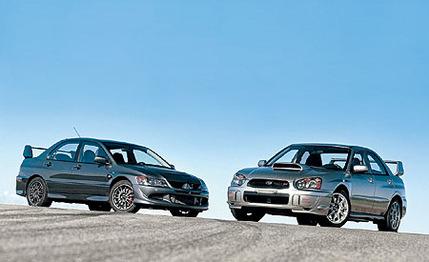 First Drive Review
First Drive Review
When Aston Martin embarked on the Vanquish coupe project in 1997, it could hardly have anticipated the horsepower race that has reached a frenzy in recent times in Europe. Not known back then was BMW's plan to put 500 horsepower in an M5 or the 600-plus-horsepower road cars since produced by Mercedes and Porsche.
Aston's only challenge at the time would come from the Ferrari 550 Maranello. As it turned out, Aston's 5.9-liter V-12 engine produced 460 horsepower, which didn't quite match the Ferrari's output of 479. And the Vanquish weighed in above the Ferrari. Nonetheless, when they met in a C/D comparison test in November 2001, the result was tantalizingly close, with the Maranello emerging victorious by just a two-point margin.
Not long afterward, Ferrari upped the ante, turning its 550 into the 575M, with 508 horsepower, and mimicked the Aston by fitting the F1 robotized gearshift. And last year the House of Enzo introduced the 612 Scaglietti, constructed in aluminum like the Vanquish and with the 5.7-liter V-12 pumped up to 533 hp.
While its flagship was being overtaken by these developments, Aston complicated the issue further by introducing the DB9 coupe, using the V-12 engine with only 16 fewer horses, and a chassis that's also made of aluminum, albeit by a simpler process. It was of similar size to the Vanquish, but better-looking and better-finished, and it cost some $70,000 less, too.
Aston Martin was confident the DB9 would not cannibalize the Vanquish, and so it was-Vanquish production continues at 350 cars a year. There are always those who must have the more exclusive and most expensive top-of-the-range model.
It is time, then, to redress the balance and give the Vanquish a chance to live up to its name. It has now been given an increase in horsepower to 520 and a suite of modifications that give it a more aggressive edge. The reworked model is called the V-12 Vanquish S and, at $255,000, is about 20 grand more than the original (which remains available).
Rather than relying on some form of supercharging-and there is not much room under the Vanquish hood-the Aston V-12 has been developed in the old-fashioned way. It's gotten a higher compression ratio, new cylinder heads with subtly reshaped combustion chambers and fully machined inlet ports, new forged connecting rods, a revised injection system, and a remapped electronic control unit. It revs higher than it did (maximum power is at 7000 rpm), allowing shorter overall gearing but still achieving a claimed top speed of more than 200 mph. The Vanquish we tested in 2001 hit 60 in 4.4 seconds and 100 in 10.3, and it's likely the S will improve on those times by a couple of 10ths.
Starting the Vanquish is still a nice piece of theater: Switch on the ignition, wait for the check lights to clear, press the brake, select neutral by pulling on both steering-wheel paddles, then press the central starter button, and- whuummff! The deep thrumming exhaust note, which returns beyond 4000 rpm, is wonderfully exciting. The electrohydraulic gearshift-basically, the same as Ferrari's-changes down smartly, blipping the throttle automatically, but upshifts can feel hesitant. The S is clearly more eager in the midrange and goes very fast indeed on a wide open road but, oddly, feels less fierce than the original Vanquish.
That may be because it has better comportments. Last year, Aston developed a "Sports Dynamics" package for the Vanquish that included stiffer springs and dampers, meatier brakes, and shorter steering arms and revised geometry that make for a quicker steering response. These modifications are standard on the Vanquish S, combined with new lightweight forged-aluminum 19-inch wheels and specific Yokohama tires. The result is lots of grip, more confident fast cornering, with the driver less aware of the car's weight. And considering the firmness of the suspension, we find the ride is remarkably comfortable.
By today's standards, control efforts-steering, throttle, brake-are heavy. Aston has dispensed with the awful part-plastic steering wheel of early Vanquishes-and generally tidied up the cabin. The sport seats with deep shoulder wings are excellent, and the matching hand-stitched leather trim now extends across what had been a painted-aluminum fascia centerpiece. The rest of the surroundings are a mixture of neat (cast aluminum handles and door pulls) and unworthy (switches from owner Ford, with ill-matched plastic surrounds). The next generation of Astons, exemplified by the DB9, does these things better.
Outside, you have to be an Aston expert to spot the difference between a Vanquish and a Vanquish S. The grille is wider and has more curvature, there is a splitter lip under the nose, and the trailing edge of the trunklid is flicked up to aid high-speed stability and, conveniently, to accommodate the center brake light.
The manufacturer describes this car as the fastest-ever Aston Martin. We used to describe the Vanquish as the fastest and most expensive car in the Ford firmament, but now there is the Ford GT. So the Aston Martin V-12 Vanquish S is just the most expensive.